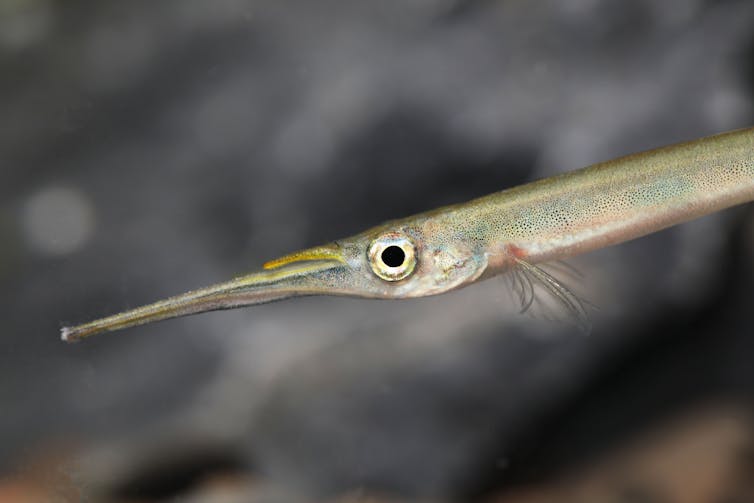
Alienacanthus is a member of an extinct group of fish referred to as placoderms
Vertebrates are outlined as all animals that possess a vertebral column, or spine. Most residing vertebrates additionally possess jaws, enamel and paired fins or limbs.
Fossils of the earliest vertebrates assist us perceive not solely how these options originated, but additionally how they developed and diversified over time.
Our research, revealed in Royal Society Open Science, examines 365-million-year-old fossils of a fish with the world’s longest underbite, referred to as Alienacanthus malkowskii. These fossils reveal the range of jawed vertebrates early on throughout their evolution.
Alienacanthus is a member of an extinct group of fish referred to as placoderms, that are among the first jawed vertebrates. They’re armoured fish of varied styles and sizes and are important to understanding the evolution of vertebrates and their options, notably jaws and enamel.
Collectively, placoderm jaws and enamel maintain proof of feeding methods and diets, giving us insights into what and the way a few of our fishy ancestors ate.
From backbone to jaw
In 1957, Polish paleontologist Julian Kulczycki described fossil fishes from the Polish Holy Cross mountains. Amongst these finds had been two partially damaged lengthy skinny bones which he thought had been some weird-looking fin spines from a fish. The odd form of the so-called spines gave the animal its identify, Alienacanthus.
Within the late Nineteen Nineties to early 2000s, members of our analysis workforce got here throughout some Moroccan specimens within the collections of the Muséum nationwide d’Histoire naturelle in Paris that included the identical bony components. The workforce later encountered extra specimens from Poland and Morocco, which we recognized as belonging to a placoderm.
Alienacanthus had an enormous, rounded head with a sharp snout and huge eyes. What Kulczycki had recognized as spines turned out to be the decrease jaws, which prolonged well past the closing of the mouth, in contrast to the higher jaws. The enamel had been sharp, barely curved in the direction of the again to entice stay prey, and the enamel continued previous the closing of the mouth.
Not like in different placoderms, the higher jaws of Alienacanthus had been able to a slight motion independently of the cranium, serving to to accommodate the decrease jaw.
Most excessive case
The prolonged decrease jaw of Alienacanthus, twice so long as the cranium, is exclusive amongst placoderms and very uncommon in different residing and fossil teams. In most animals, jaw protrusion is seen within the higher jaw, like within the swordfish, or each higher and decrease jaws like ichthyosaurs or gharials.
Amongst residing species, solely a tiny fish referred to as the halfbeak exhibits an elongated decrease jaw. The halfbeak measures simply 5 to 10 cm in size, whereas Alienacanthus‘ head and jaws alone attain 80 cm. The relative size of the decrease jaw can also be 20 per cent higher than within the halfbeak.

Alienacanthus additionally holds the title of the oldest case of decrease jaw elongation. The earlier report belonged to the 310-million-year-old shark Ornithoprion.
The Age of fishes
Alienacanthus and relations lived through the Devonian interval (358 to 419 million years in the past), additionally referred to by paleontologists because the Age of fishes. Throughout this time, quite a lot of fish teams dominated the oceans, together with sharks, bony fishes, jawless fishes and placoderms, which collectively illustrated a variety of physique, head and jaw shapes.
Alienacanthus stretches that range to the restrict with such a singular look. Fifteen million years after this animal’s prevalence, placoderms met their demise.
The evolution of extra complicated jaws allowed for a wider vary of feeding and searching strategies. The oldest placoderms favoured a fast-closing mouth for catching prey. However some placoderms began feeding on durophagous animals, with onerous shells and exoskeletons, and others might have been filter-feeders.
Alienacanthus used its sharp enamel to catch and entice stay prey, probably utilizing its elongated jaw to confuse or injure its future meal, as seen in swordfish and a few ichthyosaurs.
Studying extra
The additional again in time we go, the extra our planet’s continents regarded completely different. Throughout the Late Devonian interval, when Alienacanthus lived, Poland was located on the northeastern coast and Morocco on the southern coast of an unlimited ocean. The presence of the identical species on each ends exhibits that migration occurred in that ocean at the moment, regardless of sea stage fluctuation.
Alienacanthus contains simply certainly one of quite a few latest finds in Poland and Morocco from the Late Devonian interval. Such discoveries illustrate the remaining excessive potential for deposits of this age to disclose crucial insights about early vertebrates.![]()
(Authors: Melina Jobbins, Researcher, Evolutionary Biology, College of Zurich; Christian Klug, Professor, Curator of the Palaentological Museum, College of Zurich, and Martin Rücklin, Analysis group chief, Naturalis Biodiversity Heart and Senior researcher, Instituut Biologie Leiden, Leiden College)
(This text is republished from The Dialog beneath a Artistic Commons license. Learn the unique article)
(Apart from the headline, this story has not been edited by NDTV employees and is revealed from a syndicated feed.)

